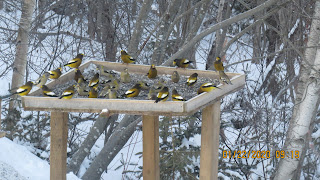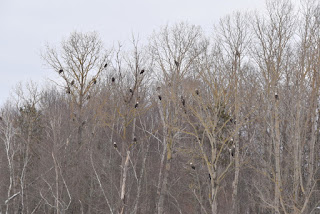NATURE MONCTON INFORMATION LINE, 25
January 2020 (Saturday)
To view the photos mentioned in this
edition go to http://nminfoline.blogspot.ca
One click on the photos
opens them full screen
To respond by email, please address your
message to the information line editor, nelsonpoirier435@gmail.com
Please advise the editor
at nelsonpoirier435@gmail.com if any errors are noted in wording or photo labelling.
Note that corrections, deletions, or delayed additions may not always
appear on the info line and email transcript but will always appear on the
BlogSpot. For this reason, it is recommended that those wishing to look at
historical records use the BlogSpot rather than the email transcript. The
BlogSpot can always be accessed from the website.
For more information on Nature Moncton,
check the website at www.naturemoncton.com
Edited by: Nelson Poirier nelsonpoirier435@gmail.com
Transcript by: Catherine Clements
Info Line #: 506-384-6397 (384-NEWS)
**Jim Wilson shares some very interesting
information in follow-up to the CAROLINA WREN [Troglodyte de Caroline] chatter
of yesterday. Jim says “a pair of Carolina Wrens appeared at a residence in
Westfield near Saint John a few years ago, also in mid-winter. First there was
one, later two. They hung around till March, when one began to sing
occasionally, with progressive frequency. Sometime in April, they began
carrying nest material into a birdhouse erected for TREE SWALLOWS [Hirondelle
bicolore] at the peak of a shed. At that point, the owners decided they would
keep the nesting news quiet to avoid disturbance of the pair. The Wrens raised
a brood successfully by early June, and after a few weeks started nest-building
again in an abandoned former bird feeder right next to their deck. They raised
a second brood there before summer’s end. By the next summer, all had
disappeared, and as far as Jim knows, they never came back. This was only the
second known successful nesting in New Brunswick. The first was at the Marathon
Inn on Grand Manan a few years before, also a two-nesting summer. Jim suggested
that if there are no birdhouses on the Riverview property, it would be nice to
have one or two erected before too long.”
Following Jim’s advice, 3 Nature Moncton nest
boxes will be delivered/erected in the area.
**After seeing Rose-Alma Mallet’s report
from their Thursday outing, Gordon Rattray made a run to the Harvey area,
seeing 3 female COMMON MERGANSER [Grand Harle] around the Harvey dam. At John
Inman’s 225 Mary’s Point Road feeder, he found approximately 20 AMERICAN TREE
SPARROWS [Bruant hudsonien], 2 SONG SPARROWS
[Bruant chanteur], 1 brilliant male NORTHERN CARDINAL [Cardinal rouge], and a RED-TAILED
HAWK [Buse à queue rousse]. At the Larsen Marsh, he spotted a NORTHERN HARRIER
[Busard Saint-Martin] and a pair of MALLARD DUCKS [Canard colvert]. At Mary’s
Point, Gordon saw 2 DARK-EYED JUNCOS [Junco
ardoisé], 10 PINE SISKINS [Tarin des pins], and a pair of WHITE-WINGED
CROSSBILLS [Bec-croisé bifascié], and got several great photos. At his home in
Weldon, he had a male PURPLE FINCH [Roselin pourpré] arrive on Friday morning.
Purple Finch are starting to show up more at feeder yards.
**An always interesting report from the
feeder yard of Wayne Corcoran, who lives in McKinleyville, route 118 outside
Miramichi. Wayne’s feeder yard seems to be the EVENING GROSBEAK [Gros-bec
errant] capital of New Brunswick at the moment, in the 140-160 range. Brian
Stone and I were sleuthing that route two years ago and spotted some Evening
Grosbeaks. We turned back to investigate and were awestruck at the sheer
numbers present. That activity continues. Wayne’s AMERICAN GOLDFINCH
[Chardonneret jaune] numbers are approximately 40, and he had his first PURPLE
FINCH [Roselin pourpré] of the year come to his yard on Friday. He also has
CANADA JAYS [Mésangeai du Canada] that do not come to his main feeders but are
resident on a woods trail behind his home. He has seen 4 there at the same time
recently that show their gratitude quickly when Wayne visits the area with
morsels of bread.
**Krista Doyle caught some photos of a 22
degree solar halo around the sun as it rose into the sky on Friday morning with
just the right conditions to create this phenomenon. Brian Stone suggests to
review the attached site to understand what creates these solar halos, and what
or what not they may mean.
Bev Schneider came
across 16 Honey Bees dead on the snow surface of a trail to wonder the reason. Glen Nichols is a bee
keeper in Aulac and in consult with his thoughts shares the following
interesting information to be aware of if we see Honey Bees dead on the snow or
moving about in winter. Louise shares Glen’s comments…
“Your email is timely because I was going to send you
the attached photos of dead Honey Bees in the snow. I double-checked with
Glen on this. Bees are active in the hive all winter. On warmer
days, they will take short flights to defecate called "cleansing
flights". Around Glen's hives right now are some brown/yellow spots
which are the bees' "evacuations." They may also leave the hive
to die (or if they die in the hive, their bodies will be thrown out) -- and
again, around Glen's hives there are a number of dead bees. The two I
photographed, however, I found Friday in the snow some distance from the hives,
so they must have flown across the yard which is pretty neat for this time of
year!”
Glen also suggests visiting the attached site which
explains this scenario.
**Jane LeBlanc reports it has been 20
years since they went to the Sheffield Mills site in the Annapolis Valley in
Nova Scotia to attend the Eagle [Pygargue à tête blanche] weekends designed for
visits. They went this year on January 22nd and 23rd (Wednesday and Thursday)
and share some photos. One photo shows one bird as being leg-banded, as per the
arrow on the photo. The official Eagle weekends this year are January 25-26 and
February 1-2. Jane suggests it is a plan to not necessarily go on the weekends,
as up to 1,000 people attend, and may tend to spook the Eagles. The farm site
that is traditionally watched will be putting out chicken carcasses until
March, so there’s still time to pay a visit after the weekends. It’s a good
plan to peruse some of the surrounding areas and visit the dykeland areas, as
other raptors like ROUGH-LEGGED HAWKS [Buse
pattue], RED-TAILED HAWKS [Buse à queue rousse], and other surprises can
show up.
Nelson Poirier,
Nature Moncton
WHITE-WINGED CROSSBILL (FEMALE). JAN 24, 2020. GORDON RATTRAY
WHITE-WINGED CROSSBILL (MALE). JAN 24, 2020. GORDON RATTRAY
NORTHERN CARDINAL. JAN 24, 2020. GORDON RATTRAY
NORTHERN CARDINAL. JAN 24, 2020. GORDON RATTRAY
SOLAR HALO. JAN 24, 2020. KRISTA DOYLE
SOLAR HALO. JAN 24, 2020. KRISTA DOYLE
EVENING GROSBEAKS. JAN 23, 2020. WAYNE CORCORAN
EVENING GROSBEAKS. JAN 23, 2020. WAYNE CORCORAN
CANADA JAY. JAN 23, 2020. WAYNE CORCORAN
CANADA JAY. JAN 23, 2020. WAYNE CORCORAN
BALD EAGLES. JAN. 23, 2020. JANE LEBLANC
BALD EAGLES. JAN. 23, 2020. JANE LEBLANC
BALD EAGLES. JAN. 23, 2020. JANE LEBLANC
BALD EAGLES. JAN. 23, 2020. JANE LEBLANC
BALD EAGLES. JAN. 23, 2020. JANE LEBLANC
AMERICAN TREE SPARROW. JAN 24, 2020. GORDON RATTRAY
AMERICAN GOLDFINCH. JAN 23, 2020. WAYNE CORCORAN
SONG SPARROW. JAN 24, 2020. GORDON RATTRAY
HONEY BEE. JAN 24, 2020. BEV SCHNEIDER
HONEY BEE. JAN 24, 2020. LOUISE NICHOLS




















No comments:
Post a Comment